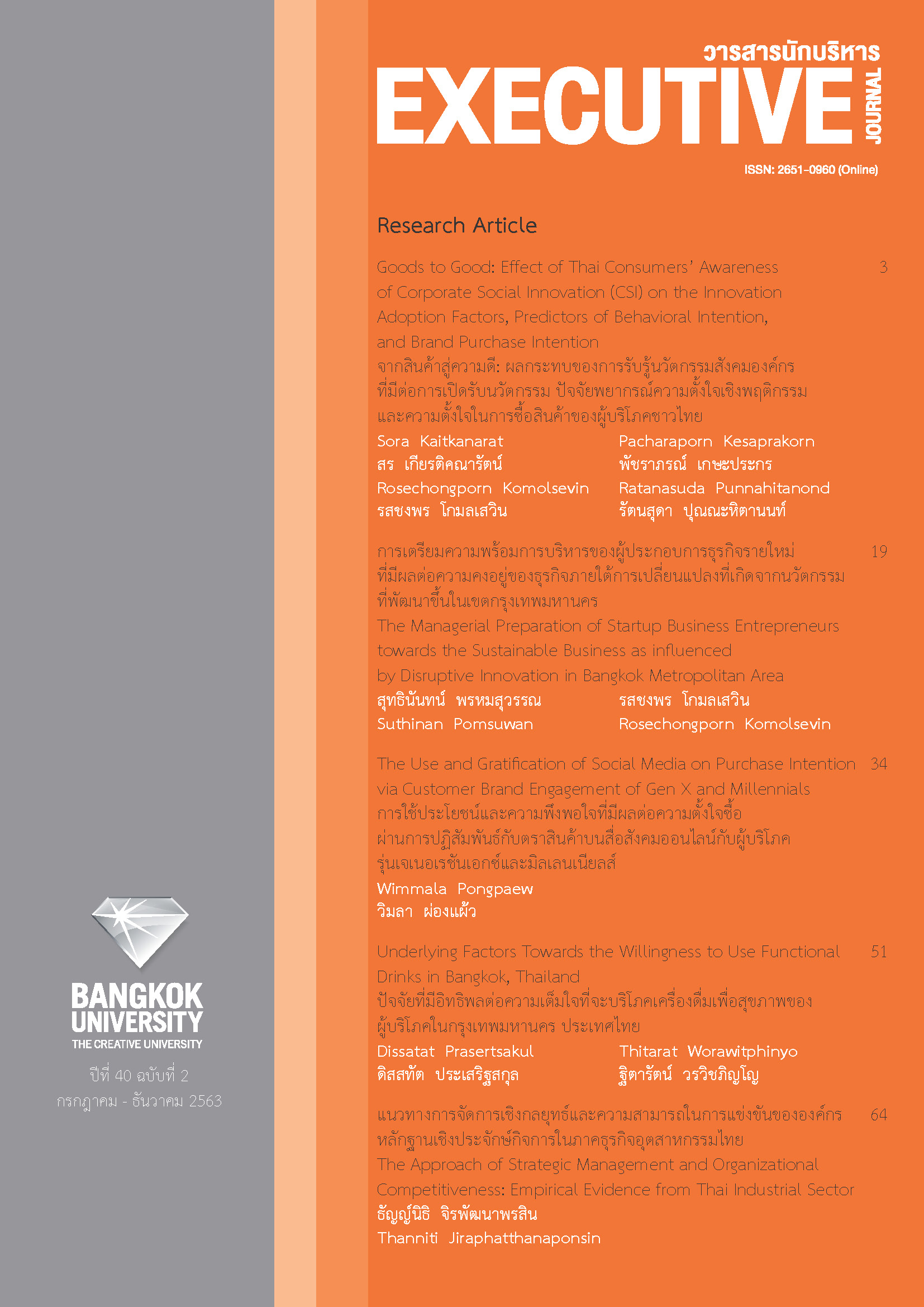Impact of Leader-Member Exchange, Communication and Corporate Social Responsibility on Employee Performance and Turnover Intention
Main Article Content
Abstract
From past to present, many organizations have tried to identify the factors that can have impact on turnover intention and employee performance. The factors that most organizations tend to focus on are organizational commitment and job satisfaction. However, the author considers both factors to be ambiguous and difficult to apply in practice. After performing literature review and qualitative synthesis, factors that can be considered to be clearer and easier to apply in practice are leader-member exchange, communication and corporate social responsibility. These three factors can have a direct impact on employee performance and turnover intention, together with an indirect impact through organizational commitment and job satisfaction.
Article Details
The manuscript submitted for publication must be the original version, submitted only to this particular journal with no prior acceptance for publication elsewhere in other academic journals. The manuscript must also not violate the copyright issue by means of plagiarism.
References
Alfermann, A. (2011). The effects of corporate social responsibility on employee engagement in a global setting (Doctoral dissertation, Benedictine University).
Ali, K. (2014). The effects of leader-member exchange and employee wellbeing towards employee turnover intention (Doctoral dissertation, Deakin University).
Allen, N. J., & Meyer, J. P. (1990). The measurement and antecedents of affective, continuance and normative commitment to the organization. Journal of Occupational Psychology, 63(1), 1-18.
Apker, J., Propp, K. M., & Zabava Ford, W. S. (2009). Investigating the effect of nurse-team communication on nurse turnover: Relationships among communication processes, identification, and intent to leave. Health Communication, 24(2), 106-114.
Carnahan, S., Kryscynski, D., & Olson, D. (2017). When does corporate social responsibility reduce employee turnover? Evidence from attorneys before and after 9/11. Academy of Management Journal, 60(5), 1932-1962.
Chaudhary, R. (2018). Corporate social responsibility and employee performance: A study among Indian business executives. The International Journal of Human Resource Management, 1-24. https://doi.org/10.1080/09585192.2018.1469159
Garriga, E., & Melé, D. (2004). Corporate social responsibility theories: Mapping the territory. Journal of Business Ethics, 53(1), 51-71.
Hollingworth, D., & Valentine, S. (2014). Corporate social responsibility, continuous process improvement orientation, organizational commitment and turnover intentions. International Journal of Quality & Reliability Management, 31(6), 626-651.
Jalalkamali, M., Ali, A. J., Hyun, S. S., & Nikbin, D. (2016). Relationships between work values, communication satisfaction, and employee job performance: The case of international joint ventures in Iran. Management Decision, 54(4), 796-814.
Joo, B. K. (2010). Organizational commitment for knowledge workers: The roles of perceived organizational learning culture, leader–member exchange quality, and turnover intention. Human Resource Development Quarterly, 21(1), 69-85.
Kacmar, K. M., Witt, L. A., Zivnuska, S., & Gully, S. M. (2003). The interactive effect of leader– member exchange and communication frequency on performance ratings. Journal of Applied Psychology, 88(4), 764-772.
Kang, D. -S, Stewart, J., & Kim, H. (2011). The effects of perceived external prestige, ethical organizational climate, and leader-member exchange (LMX) quality on employees' commitments and their subsequent attitudes. Personnel Review, 40(6), 761-784.
Kelman, H. C. (1958). Compliance, identification, and internalization: Three processes of attitude change. Journal of Conflict Resolution, 2(1), 51-60.
Kim, H., & Lee, S. Y. (2009). Supervisory communication, burnout, and turnover intention among social workers in health care settings. Social Work in Health Care, 48(4), 364-385.
Kim, J., Song, H. J., & Lee, C. -K. (2016). Effects of corporate social responsibility and internal marketing on organizational commitment and turnover intentions. International Journal of Hospitality Management, 55, 25-32.
Klein, H. J., Becker, T. E., & Meyer, J. P. (Eds.) (2009). Commitment in organizations: Accumulated wisdom and new directions. New York: Routledge.
Klonoski, R. J. (1991). Foundational considerations in the corporate social responsibility debate. Business Horizons, 34(4), 9-18.
Kuzmycz, D. (2011). Coaching behaviors of managers as a predictor of higher quality leader- member exchanges and employee engagement (Doctoral dissertation, Alliant International University).
Law, K. S., Wong, C. -S., Wang, D., & Wang, L. (2000). Effect of supervisor–subordinate guanxi on supervisory decisions in China: An empirical investigation. The International Journal of Human Resource Management, 11(4), 751-765.
Lawler, E. E. (1973). Motivation in work organizations. Monterey, CA: Brooks/Cole.
Leary-Joyce, J. (2004). Becoming an employer of choice: Make your organisation a place where people want to do great work. London: Chartered Institute of Personnel and Development.
Lin, C. -P., & Liu, M. -L. (2017). Examining the effects of corporate social responsibility and ethical leadership on turnover intention. Personnel Review, 46(3), 526-550.
Maslow, A. H. (1943). A theory of human motivation. Psychological Review, 50(4), 370-396.
Mda, A. M. (2010). Staff Turnover in the Information and Communication Technology (ICT) Sector in South Africa (Doctoral dissertation, Ohio University).
Miles, E. W., Patrick, S. L., & King, W. C. (1996). Job level as a systemic variable in predicting the relationship between supervisory communication and job satisfaction. Journal of Occupational and Organizational Psychology, 69(3), 277-292.
Neves, P., & Eisenberger, R. (2012). Management communication and employee performance: The contribution of perceived organizational support. Human Performance, 25(5), 452-464.
Northouse, P. G. (2016). Leadership: Theory and practice (7th ed.). Thousand Oaks, CA: Sage.
Reichers, A. E. (1985). A review and reconceptualization of organizational commitment. The Academy of Management Review, 10(3), 465-476.
Richardson, J. (2018). The relationship between the perceived effectiveness of coaching with job engagement and organizational engagement (Doctoral dissertation, Capella University).
Smith, J. (2013). Study of leader follower relationship quality and employee commitment in a public housing agency with communication as the mediating variable (Doctoral dissertation, Our Lady of the Lake University).
Williams, D. (2017). Strategic corporate social responsibility (CSR) in the service industry: Employing employee engagement in strategy implementation toward enhancing organizational competitive advantage (Doctoral dissertation, University of Maryland University College).
World Economic Forum. (2018). The future of job report 2018. Retrieved September 8, 2018, from http://www3.weforum.org/docs/WEF_Future_of_Jobs_2018.pdf


